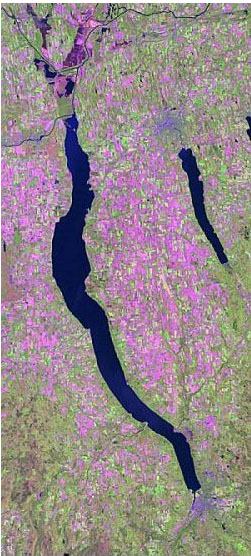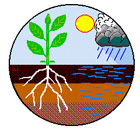

|
Graduate Student Research
Participatory
research data collection methods for accuracy assessment of land-cover
maps
This project is part of John Sydenstricker-Neto’s (Dept. Development
Sociology) dissertation research entitled Land Cover Changes and Social
Organization in Brazilian Amazonia: A Temporal Spatial Analysis, 1986-1995/99.
The primary goal of the dissertation is to unfold how historically grounded
local social relations and specific conditions of natural resource systems
have jointly shaped the ways in which settlers use their agricultural
parcels and common-forest reserves. The project links socio-demographic
information, Remote Sensing/GIS analysis, and qualitative data on local
social organizations and institutions.
The objectives of Remote Sensing/GIS analysis were to: (1) determine land
cover change in the recent colonization area for small-scale migrant farmers
(1986-2000) in the municipalities of Machadinho D’Oeste and Vale
do Anari, State of Rondonia, Brazil; (2) engage community stakeholders
in the processes of mapping and assessing the accuracy of land cover (LC)
maps; and (3) evaluate the relevance of LC maps (inventory) for understanding
community-based land use dynamics in the study area. We were interested
in learning if there would be increased efficiencies, quality, and ownership
of the inventory and evaluation process by constructively engaging stakeholders
in local communities and farmer associations.
Landsat data were used to create maps of LC conditions for 1986, 1994,
and 1999. Images were obtained in July/August (dry season) and field data
was collected during August 2000 with the assistance of nine local farm
associations and approximately 100 independent farmers. At meetings with
the associations hardcopy false color composites of imagery data with
parcel boundaries were presented to individual landowners. Each individual
provided historical and contemporary LU for known areas. Polygons were
annotated and labeled on stable acetate for each cover type, corresponding
to the seven-category classification scheme. Notes were taken during the
interview process to indicate the dates of land clearing, cover type,
and level of uncertainty expressed by the participants.
Approximately 1,000 polygons were field annotated and random samples were
selected for classifier training and map validation. Overall accuracy
for each year ranged between 85-95% (Kappa 0.52-0.78). LC changes were
consistent with the trends observed in the study area and reported by
others. The participatory process involving local farmers was crucial
for achieving the objectives of the study. The specific protocol developed
for data collection should be applicable in a wide range of cases and
contexts.
The building of trust with the local stakeholders is important with contested
issues such as deforestation in the topics. Systematic data collection
among farmers (the primary land users) provided a valuable source of information
based on their direct observation in the field and historical data not
directly available through other sources. This procedure provided greater
confidence for interpreting and understanding classification errors. Finally,
the process itself empowered local farmers and provided a forum for discussing
land use processes in the region, including challenges to alleviate poverty,
increase agrosilvopastoral farming systems, arrest deforestation, and
study its implications for developing more effective land use policies.
Including the local stakeholders in the research was very effective process
for evaluating LC change in the region. For stakeholders and researchers,
the mapping and reporting process fosters better understanding of the
patterns and processes of environmental change in the study area. We foresee
that participatory mapping projects such as the one used in this study
have the potential to become an important planning device for regional-scale
development in Brazil. With greater economic opportunities and stronger
institutions at the local level, society is likely to improve the ability
to identify and adopt more environmentally sound LU activities. For more
information, contact John Sydenstricker-Neto at jms56@cornell.edu.
Resulting
Publications:
Sydenstricker-Neto, J., A.W. Parmenter, A.W., and S. D. DeGloria (2003).
Participatory rResearch data collection methods for accuracy assessment
of land-cover maps. Luneta, R.S. and J.G.Lyon (Ed.) Remote Sensing and
GIS Accuracy Assessment. CRC Press, Boca Raton, FL.
-

Department of Crop & Soil Sciences
Cornell University is an equal opportunity, affirmative action educator and employer.
|
Research
Outreach
ArcGIS Desktop v.10 Course Descriptions
ArcGIS Desktop I
ArcGIS Desktop II
ArcGIS Desktop III
ArcGIS Web Sessions
Video List
ArcGIS 10 Basics - 1 of 4
ArcGIS 10 Basics - 2 of 4
ArcGIS 10 Basics - 3a of 4
ArcGIS 10 Basics - 3b of 4
ArcGIS 10 Basics - 4a of 4
ArcGIS 10 Basics - 4b of 4
ArcGIS Data Formats - 1 of 2
ArcGIS Data Formats - 2 of 2
Calculating XY Values for a Feature
Clip & Intersect Tools
Connecting to Web Services
Creating a Roster Catalog
Feature Templates 1
Garmin 76SX_Inro
Geodatabase Domains
Geoprocessing Results Window
Layers
Mapping XY Data |
